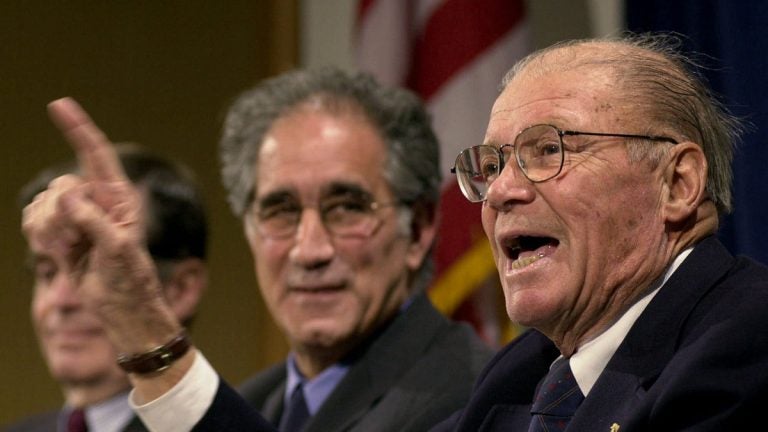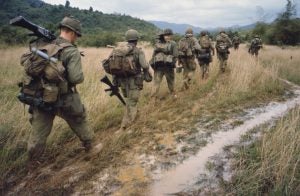Who fights our wars? Other people’s children
A volunteer-only army outsources foreign wars to the poor and working class — one of the worst legacies of Vietnam, which was also fought mostly by less-privileged Americans.

Robert McNamara, right, defense secretary under Presidents Kennedy and Johnson, is shown in 2001 at a forum at the John F. Kennedy School of Government at Harvard University in Cambridge, Mass. (AP Photo/Steven Senne, File)
This story is part of a WHYY series examining how the United States, four decades later, is still processing the Vietnam War. To learn more about the topic, watch Ken Burns and Lynn Novicks’ 10-part documentary “The Vietnam War” running Sunday, Sept. 17 at 8 p.m. through Thursday, Sept. 28 on WHYY-TV.
—
As secretary of defense in the 1960s, Robert S. McNamara pushed so hard for increasing America’s military commitment in Vietnam that the conflict became known as “McNamara’s War.” Later, he came to regret his role in escalating it. “We were wrong, terribly wrong,” McNamara said in 1995, when he published a memoir on Vietnam. “We owe it to future generations to explain why.”
But McNamara got one thing right. In 1966, he proposed replacing America’s military draft with universal national service. At the time, the idea went nowhere. Now it’s time for us to revive it.
As the recent conflicts in Iraq and Afghanistan remind us, a volunteer-only army outsources our foreign wars to the poor and working class. That’s one of the worst legacies of Vietnam, which was also fought mostly by less privileged Americans.
In 1965, only one-fifth of male soldiers had some education beyond high school; overall, for Americans aged 18 to 21, the fraction was almost one half. And one of the big reasons for that was the draft, which let the well-to-do buy their way out.
Some people hired lawyers, who discovered creative loopholes in the conscription law; others engaged doctors, who diagnosed ailments that allegedly rendered them unfit for combat. In 1968, for example, President Trump received his fifth and final deferment from the draft after a physician found that he had bone spurs in his feet.
Prior to that, he avoided the draft in a more pedestrian fashion: by going to college. It’s a myth that all students were exempt from conscription; most notably, Stanford student body president David Harris was jailed in 1969 for refusing induction. (Harris was married to folk singer Joan Baez, who was pregnant with their child when he was imprisoned.)
But most students did manage to evade conscription, because local draft boards typically gave them deferments. Others enlisted in National Guard units, which let them fulfill their military duty without going to Vietnam.
That was the route taken by our last Republican president, George W. Bush, who enlisted in the Texas Air National Guard two weeks before he graduated from Yale in 1968. Bush had scored only 25 percent on the “pilot aptitude” test, the lowest acceptable grade. But his dad was a congressman, who allegedly helped pull some strings to get him into the unit — and out of Vietnam.
Earlier that year, President Lyndon Johnson had ended draft deferments for graduate students. So Bush couldn’t avoid the draft by enlisting in more school. And neither could Bill Clinton, who graduated from college in 1968 as well.
Clinton nevertheless got permission from his draft board in Arkansas to go to England for a Rhodes Scholarship; upon his return, he signed up for the Reserve Officers Training Corps, even though he had no intention of serving in the military. If you were in military training, ironically, you got a draft deferment.
You get the idea. The draft was so locally determined — and so loosely enforced — that almost anyone with means could find a way out.
And the draft was increasingly unpopular, too. Richard Nixon, Hubert Humphrey, and Robert Kennedy all campaigned for president in 1968 on a platform to end it. Upon winning the White House, Nixon appointed a panel to “reform” — but really, to remove — military conscription.
The panel’s members included GOP economists Martin Anderson and Milton Friedman. Contrary to what most Americans believe, it wasn’t long-haired radicals who brought conscription to an end; it was libertarian Republicans, who argued that compulsory military service violates “the freedom of the individual to determine his own life,” as the panel concluded.
But in America, some people have more freedom to determine their own lives than others do. The panel’s solution — the all-volunteer army — didn’t solve the problem of inequity in military service; instead, the problem got bigger. When service was no longer compulsory, people with fewer life options became more likely to “choose” it.
That’s why Massachusetts Sen. Ted Kennedy and New York Rep. Charles Rangel — two of the most liberal lawmakers in America — both opposed Nixon’s efforts to eliminate the draft. As Kennedy dryly noted, most people favoring an all-volunteer army had no wish to volunteer themselves. The result would be a “mercenary” force rather than a volunteer one, Rangel warned, “composed of men soldiering for a pay check.”
The draft ended in 1973, replacing a highly unequal conscription system with an even more unequal volunteer one. And that brings us back to Robert McNamara, who had the right idea all along.
By definition, McNamara told an audience of journalists in 1966, the Selective Service System only drew on “a minority of eligible young men.” That’s an “inequity,” he said, and it needed to end. We should require every young American to do two years of service, McNamara argued, whether in the armed forces or in non-military settings.
There’s never been a more propitious time for that than right now. In every way we can measure, our country has become more unequal since the Vietnam era. A required national-service stint would bring people from different backgrounds together to pave our roads, clean our parks, and care for our elderly. And, most of all, it would also spread the responsibility of fighting our wars more evenly across the class spectrum.
There would be important details to work out, of course, especially regarding who did military and non-military service. Some people have suggested a lottery, which would assign these duties randomly; others argue that the term for military service could be shorter, which might induce more people to choose it.
One way or another, though, we have to figure out how to engage every American in serving the nation. We got rid of the draft in the Vietnam years, for some very good reasons, but we didn’t find a good substitute for it. We’re still saddling a small portion of our countrymen with the entire country’s defense. The rest of us are just free riders, content to let other people’s children substitute for our own.
—
To learn more, watch Ken Burns and Lynn Novicks’ 10-part documentary “The Vietnam War” running Sunday, Sept. 17 at 8 p.m. through Thursday, Sept. 28 on WHYY-TV. WHYY Members will have extended on-demand access to the series via WHYY Passport through the end of 2017.
Jonathan Zimmerman teaches education and history at the University of Pennsylvania. He is the author (with Emily Robertson) of “The Case for Contention: Teaching Controversial Issues in American Schools,” which was published in April by University of Chicago Press.
WHYY is your source for fact-based, in-depth journalism and information. As a nonprofit organization, we rely on financial support from readers like you. Please give today.





